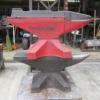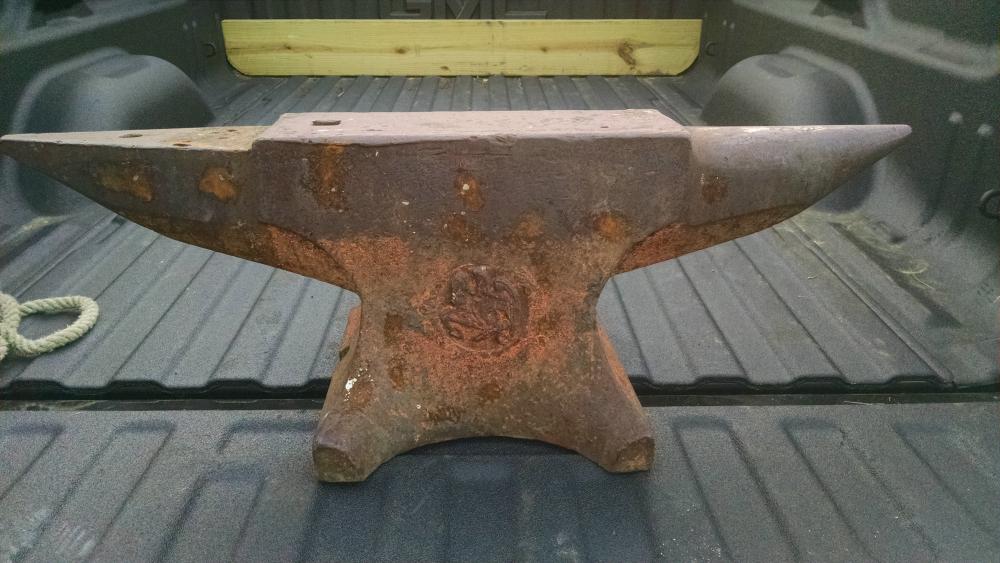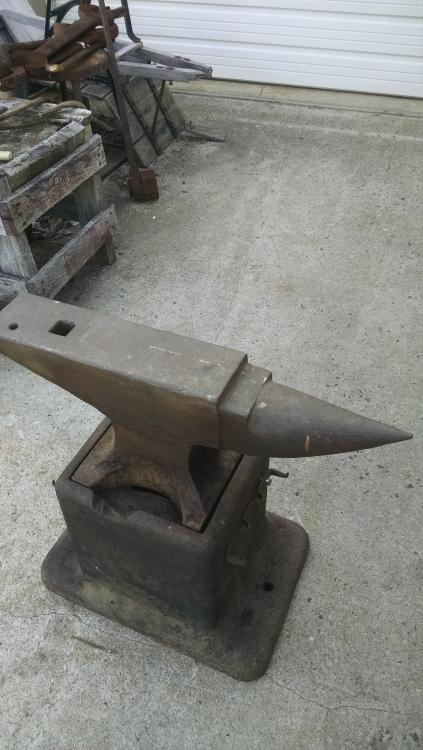-
Posts
2,481 -
Joined
-
Last visited
Content Type
Profiles
Forums
Articles
Gallery
Downloads
Events
Everything posted by njanvilman
-
Check that anvil carefully for rebound and soundness. Going by your picture alone, it looks like there "might" have been welding repairs done to all of the edges. This does not neccessarily affect it, but check it carefully. Or someone just flap sanded/ground all around the top to "improve" the edges. Either way, check it out carefully.
- 661 replies
-
- Cast anvil
- Fisher & Norris
-
(and 1 more)
Tagged with:
-

Need help aging a 166 lb hay budden
njanvilman replied to Masters's topic in Anvils, Swage Blocks, and Mandrels
Yes, second year of production. -
New addition to Fisher & Norris History: Double Horn Yorkshire style Fisher anvil. 280 lb. This is probably a custom, one-off anvil. This style is different from the Insonora export anvil, and different from the European Double Export anvil that Fisher made. This is the only one I have ever seen. This style was not advertised at all. Fisher claimed to have over 300 stock patterns, and would make any style pattern if they did not have what the customer wanted. If you want to see it, come to NJ to visit the Fisher & Norris Factory Museum.
- 661 replies
-
- Cast anvil
- Fisher & Norris
-
(and 1 more)
Tagged with:
-

Need help aging a 166 lb hay budden
njanvilman replied to Masters's topic in Anvils, Swage Blocks, and Mandrels
If is is 8110, it is 1893. If there was a number after the 8110_, it would be 1902. It is hard to tell if a digit was obliterated leaving only a corner of it, or not. -
What looks like a weld is only where the two parts of the pattern came together in the mold. On some Fisher anvils, this is invisable, on others, it is more pronounced. But it is not a weld. The anvil was cast in one piece.
-
According to AIA, it was forged in 1894, in Brooklyn, NY.
-

thoughts on this Fisher Anvil
njanvilman replied to JT's topic in Anvils, Swage Blocks, and Mandrels
This anvil has been on EBXX for several months. To me, it looks like a nice garden decoration. Yes, those look like cracks under the faceplate, and also about an inch down on that jagged line. That missing iron under the faceplate is troubling. A good hammer blow could bend/crack/displace a piece of the plate. I think this anvil has had problems for a long time; it probably should never have been sold. -

Craigslist Fisher just picked up? Whatya think?
njanvilman replied to King187's topic in Anvils, Swage Blocks, and Mandrels
One of the lines in some of the vintage ads for Fisher is: "Fisher anvils make you money, they do not make you deaf." Even more than a hundred years ago Fisher& Norris recognized one of the big advantages of a Fisher anvil. Their advertising was serving to educate people that a "ringing" anvil did not indicate a superior product over a "non ringing" one. An anecdote about this: I was at a PABA meet years ago where Peter Ross demoed. He insisted on having a Fisher anvil to work on so he could talk during his hammering! -
Fisher supplied anvils to the US Govt for about 100 years. Was this on a US Navy ship?
-

Large Saw Makers or Sawyers Anvil
njanvilman replied to JT's topic in Anvils, Swage Blocks, and Mandrels
Nice Fisher! -

Craigslist Fisher just picked up? Whatya think?
njanvilman replied to King187's topic in Anvils, Swage Blocks, and Mandrels
If you are referring to advertising in AIA, we have all seen them. If you have original advertising from pre 1950, there is no copyright on it. I still do not understand you prejudice against Fisher anvils, based on ads alone. It is sort of saying you would not buy a Ford today, because of advertising for the 1958 Edsel. -

Craigslist Fisher just picked up? Whatya think?
njanvilman replied to King187's topic in Anvils, Swage Blocks, and Mandrels
Nice Fisher. Could you post photos of all sides? At some point, you might want to unbolt it from the base and weigh it. As to Fisher advertising: Remember, they had a product to sell, and sell they did. Fisher sold over 500,000 anvils over their roughly 125 year history. They were the first major anvil manufacturer in the US, and made more anvils in the US than any other company. They warrantied their anvils for a year, which no other company did. And the fact that so many have survived and are still in use stands in testament to their quality. Yes, many did fail, from use, abuse, or defects. I find it interesting that someone would complain about advertising for a product that has not been made for 38 or more years now, and it would affect their judgement about the product. If you have copies of the advertising, please post it. I am sure we would all like to see it. -

Large Saw Makers or Sawyers Anvil
njanvilman replied to JT's topic in Anvils, Swage Blocks, and Mandrels
Make sure you also photograph the under-side base. A lot can be learned from all sides. -
121 indicates the weight in lbs.
-

Tell me about this anvil
njanvilman replied to brickman's topic in Anvils, Swage Blocks, and Mandrels
1925 is the year the anvil was made. It is a Soderfors brand anvil. Cast steel, high quality. -
Try to build one for $150! If the screw and box are good, buy it. Use it for the rest of you life. It becomes a cheap investment.
-
That is definitely a repair on the dynamic jaw. Either if had flaw from casting, or someone really overdid the "squeeze" and crack the casting. It does appear to have a decent weld repair; and if it has been working for a long time, leave it alone and use it.
-
Very few swage blocks were marked with a manufacturer's name. Unless you find an advertisement showing that design, you will probably never find out the origin.
-
American Star anvils were made in Trenton, NJ, from about 1852 to 1868. They only lasted 14 years! The foundry was started by a couple of former employees of Fisher. Mark Fisher actually sued them for patent infringement but lost because Star did enough things differently. These anvils tend to be on the brittle side. Do not drop it! Here at the Fisher & Norris Factory Museum, we have about 25 of this brand anvil, and about 6 of them have broken parts. Do do any repairs to it. Either use as is, or just preserve it for what it is, a chapter in American Anvil History.
-
Different tooling was created to fit into the slots/dovetails/hardy holes, etc. depending on the job to be done. It is probably technically a Cutler's anvil, but it could be used in other trades, depending on the tooling used.
-
If there is a date, it will be on the inside under the jaw on the fixed half. About half were dated.
-

just caught a monster!!
njanvilman replied to the iron dwarf's topic in Anvils, Swage Blocks, and Mandrels
I am going with 500 lb. Soho pattern? -

Question About Purchased 1891 Fisher Anvil
njanvilman replied to Lone Star Mike's topic in Anvils, Swage Blocks, and Mandrels
PM me here or at njanvilman@gmail.com if you are in the area. BTW, I am about a 85 minute drive from the bridge on 95 into NJ. Leave the edges alone. Just wire brush or wheel the anvil, hit it with any light spray oil to prevent rust, and use it. If you make to the museum, you will see what factory new edges looked like on Fisher anvils, and other conditions. Look me up on Facebook, and you will see more Fisher anvils than you ever knew existed.- 10 replies
-

Question About Purchased 1891 Fisher Anvil
njanvilman replied to Lone Star Mike's topic in Anvils, Swage Blocks, and Mandrels
Hi Mike What is a Texas boy doing buying anvils in Philadelphia? Anyway, the numbers you are looking at at batch numbers, and really have not significance today. The only number that matters is the date, 1891. This was done for Fisher's one year warranty on their anvils. So you anvil would be replaced until the end of 1892 if it failed. For more information, and if you are on Facebook, check out my page: Fisher & Norris Factory Museum Page for more information/pictures. And, yes, there is a Fisher Anvil Museum here in NJ. Pictures are on the FB page.- 10 replies
-
New addition to the Fisher & Norris Factory Museum. 200 lb Hay Budden, later model, serial number too corroded to read. It came with a nifty iron base, weighing in at 335 lb! It fit so well that I suspect it was made for this anvil. I just used detergent and a hand wire brush to clean it, then a light coat of Gibbs oil. I want to preserve the patina.


